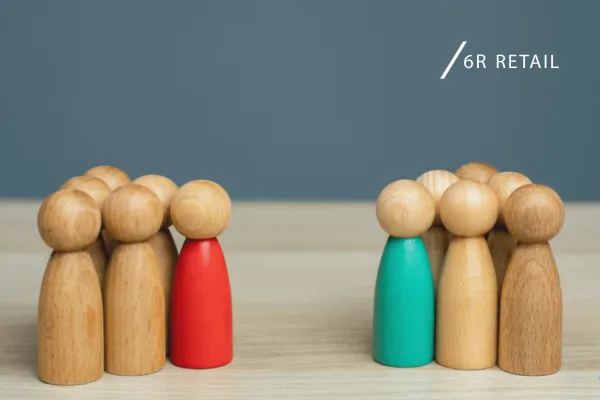Practical Tools for
Smarter Retail Projects
Explore our books, webinars, and blog to get insights that help your team move with clarity and confidence

3 Steps to Improve Teamwork Conflict in B2B Projects
In the excitement of getting started on a new project, we can easily overlook a critical factor that can make or break our projects: conflict and how we manage it.
What if I told you that it’s not conflict that’s the enemy, but rather the way we perceive and manage it—and ourselves?
I recently attended a management session on fostering Win-Win conflict led by Samantha Rush and Kylee Leota, and since then, I’ve been mulling over some of the key messages that they shared.
Types of Project Conflicts
They identified 3 types of team conflict that deserve our attention and the positive possibilities that each holds if managed well.
Task Conflict: This can be a breeding ground for innovation. Team members who passionately debate the merits of different systems or processes are actually stress-testing solutions and pushing the boundaries of what’s possible.
Process Conflict: Potentially the unsung hero of workflow efficiency. When a team member questions why you’re still using spreadsheets to track barcodes, they’re initiating a valuable discussion about efficiency and business data management.
Relationship Conflict: Possibly an unexpected bonding agent? While this seems potentially destructive, teamwork conflict can create unlikely alliances as team members unite against a common challenge.
So, the first step to better conflict management is understanding what type of conflict you actually have.
Misdiagnosis of the Conflict
We talked about various conflicts that the project leaders in the room were seeing in their teams. For one person, it was the insight that a team was interpreting a process conflict personally.
Feelings of not being well understood got in the way of finding the right way to drill down into the problem.
The fear of missing out on something important to them meant they were looking backward for evidence to prove they were right, rather than finding ways to solve the problem at hand. Mostly, this was about reframing the situation, helping both sides to see the other’s point of view.
→ On one side, what stopped us from asking questions earlier in this process?
→ On the other hand, how might we better articulate our specific needs?
The uniting force here? Solving the problem for the users and building a level of common ground, having each party reflect on how they might contribute to getting a better outcome.
The Power of the Considered Question
For a long time, I’ve been working on improving the questions I ask. It’s an important part of allowing people the safety to explore their own perceptions and to gain a better understanding of how to manage conflict in the workplace.
In navigating these conflicts, the considered question is a powerful tool. I’m listening to “Humble Inquiry” by Edgar H. Schein, who advocates for the ‘considered question’ that allows us to find common ground.
Here are some questions to help you navigate the stormy seas of conflict (the first two are my go-to questions when I feel myself having a visceral reaction to a situation):
❓ What’s triggering such a strong reaction in me?
(Hint: It’s often a mirror reflecting something about ourselves).
❓ What’s the most positive interpretation of what they’re saying?
❓ How might our different perspectives complement each other?
❓ What common goal unites us despite our disagreements?
❓ If we resolved this conflict, what new opportunities might emerge?
From Conflict to Team Collaboration: Your Three-Step Sanity Check
✅ Step 1: Identify the Conflict Type: Is it personal, process, or task? Understanding the nature of the conflict is half the battle.
✅ Step 2: Consider Questions: Use the questions above to shift perspectives and find common ground.
✅ Step 3: Redirect the Energy: Channel the management conflict energy into innovation, improvement, or team bonding.
Over years of various conflicts, B2B project management retrospectives, and reflections, I’ve developed my top two questions, which usually come to me fairly quickly after a conflict flares up.
But these questions have been developed in the quieter and saner moments outside of the immediacy of a conflict situation.
Do you have a ‘go-to’ question that keeps you sane under team conflict pressure?
By embracing the right kinds of conflict and arming yourself with powerful questions, you can turn how to deal with conflict in a team into your project management’s secret weapon.
Who knows? Your next big retail innovation might just be hiding in that heated debate about checkout optimisation; a little friction might just be the spark that ignites your next breakthrough.
The 5-Minute Challenge ⌚
Consider a recent conflict
→ What question was helpful?
→ What question could unlock an insight for you next time?
Write it down.
Repeat next time. (Over time, you’ll build the muscle memory that helps you reach for these questions in a conflict situation.)
Retail improvement, made practical.
Leadership thinking that drives change.
Sign up to receive new articles and strategic guidance.
Want the latest tools and news?
👇Get practical articles, templates, and invites to upcoming sessions; sign up.

Get your FREE 52-Week Planner and turn your goals into action! Stay organized, motivated, and on track with a bonus Goal-Setting Workbook packed with actionable strategies.
Resources
We work on lands cared for by First Nations people for thousands of years. We honour their enduring connection to country, and pay our respects to Elders past and present, knowing true progress means listening first.
© 2025 6R Retail. All rights reserved.
